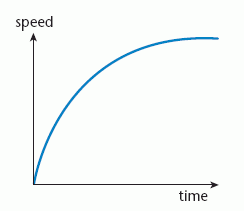Getting Going
Changing motion requires a force. Starting, stopping, getting faster or slower and changing direction all involve forces. One way to start an object moving is to release it and allow the Earth to pull it down. The Earth’s pull causes the object to accelerate downwards at the rate of 10 m s–2.
To set off on a cycle, you push down on the pedal. The chain then transmits this force to the rear wheel. The wheel pushes on the road and, provided that there is enough friction to prevent the wheel from slipping, the push of the road on the wheel accelerates the cycle forwards.
The force that pushes a cycle or other vehicle forwards is called the driving force, or motive force.
However, as every cyclist knows, this acceleration is not maintained. The cyclist eventually reaches a speed at which the driving force no longer causes the cycle to accelerate. This is due to the resistive forces acting on the cycle. The main one is air resistance, although other resistive forces act on the bearings and the tyres.
Air resistance or drag also affects the motion of an object released and allowed to fall vertically; in fact it opposes the motion of anything that moves through the air. This is due to the air having to be pushed out of the way. The faster the object moves, the greater the volume of air that has to be displaced each second and so the greater the resistive force.
The diagram shows the directions of the forces acting on a cyclist travelling horizontally and a ball falling vertically.

The effect of the resistive forces is to reduce the size of the resultant, or unbalanced, force that causes the acceleration. How this affects the speed of the cycle and ball is shown by the graph.
The decreasing gradient of the speed–time graph shows that the acceleration decreases as the resultant force becomes smaller. At a speed where the resistive force is equal to the driving force, the resultant force is zero and the object travels at a constant speed.

When the forces acting on a moving object are balanced, the constant speed is called its terminal speed or terminal velocity.
Air resistance
A cyclist is used as an example to explain what air resistance is. Drag is mentioned. Two ways to reduce air resistance are stated: reducing the area in contact with air (by the cyclist ducking down or cycling behind someone else) and by being more streamlined (wearing smoother surfaces or a more streamlined helmet).
To summarise:
- an object accelerates if there is a resultant, or unbalanced, force acting on it
- the acceleration is proportional to the resultant force and in the direction of the resultant force.
